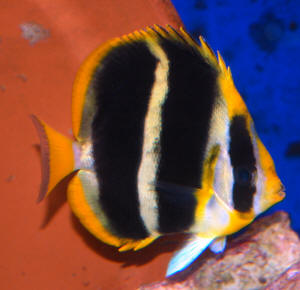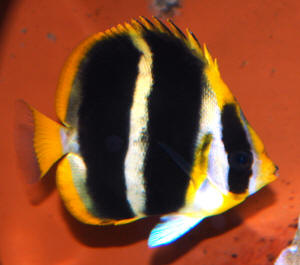|
FAQs on Genus Chaetodon
Butterflyfishes, Identification
Related
Articles: Chaetodon
Butterflyfishes
Related FAQs: Chaetodons 1, Chaetodons 2, Chaetodon Behavior, Chaetodon Compatibility, Chaetodon Selection, Chaetodon Systems, Chaetodon Feeding, Chaetodon Disease, Chaetodon Reproduction, Butterflyfish Identification, Butterflyfish
Foods/Feeding/Nutrition, Butterflyfish Compatibility, Butterflyfish Behavior, Butterflyfish Systems, Butterflyfish Selection, Butterflyfish
Disease, Butterflyfish
Reproduction,
|

|
 |
Butterflyfishes for Marine
Aquariums
Diversity, Selection & Care
New eBook on Amazon: Available
here
New Print Book on Create Space: Available
here
by Robert (Bob) Fenner |
| Re: Micro-bubbles/gas-bubble disease/Pumps and
Plumbing... and some C. tricinctus pix 3/15/08 Hi Scott,
Sorry for the slow reply, my bubble problem has only completely
cleared in the last couple of days. <Great! I must apologize for
my slow response also, it has been one of those weeks.> Once I
added the new RK2 pump things immediately improved. Bubbles reduced
to practically nothing, and the noise was cut in half. <Yes, the
typical story with these pumps.> Like last time when I added the
breather's some bubbles did come back after a few days, and the
same happened after adding the new pump. There weren't a lot of
bubbles and I believed they weren't at dangerous levels. Over
the last couple of weeks I have fiddled with a few things with
little change. It wasn't until I re-arranged the area around
the intake of the pump that I found my problem. A couple of
bio-balls had somehow gotten lose and got stuck in the intake pipe.
<That will sure make a difference.> Once removed, flow
increased, and the bubbles stopped (insert big sigh of relief).
<Yes.> In rare good timing, since I did this a few days ago
my black Ocellaris pair I had been concerned about has laid another
nest. So it seems I got through this with no great issues.
<Awesome!> As I was writing this I remembered that I was
going to try and take some pics of my Chaetodon tricinctus for your
Unknown Chaetodons page. I recently moved my Tricinctus Butterfly
into a different tank and am able to get some better shots of him
so I thought I would include a couple with this e-mail. I left them
their original size, so you can reduce them the way you like.
<Thank you, these will be passed along to Bob.> Thanks again
for your advice. Kind Regards, Ryan Dwyer <Ryan, thank you for
updating us on your situation, I am glad to hear it all worked out
well. Welcome, have fun, Scott V.> |
|
 
Very nice. Thanks Ryan. RMF
|
The Impulse Buy - Saddleback Butterfly I'm pretty new at
this marine aquarium thing, having only dealt with fresh water
aquariums for 30 plus years. >>Acquiring knowledge is, in my
opinion, the most difficult aspect of keeping marine. >Been taking
it slow, usually researching as I go, but recently couldn't resist
buying on impulse a saddleback butterfly. >>Ouch.. my friend,
these fish are so easily found... >Water quality is all good, and
all other inhabitants are doing well. Just wondering if I made a
mistake adding the butterfly. >>WithOUT quarantine? In
my very honest opinion, YES. Everything, especially
vertebrate life, must be quarantined for a minimum of 30
days. Also, this animal will need swimming space, 4'
isn't exactly the kind of space a fish that hits about 6" in
length. See these links to decide what animal you actually
have -
http://www.fishbase.org/Summary/SpeciesSummary.cfm?genusname=Chaetodon&speciesname=ulietensis
http://www.fishbase.org/Summary/SpeciesSummary.cfm?genusname=Chaetodon&speciesname=falcula
http://www.fishbase.org/Summary/SpeciesSummary.cfm?genusname=Chaetodon&speciesname=ephippium
(the pic in this last link doesn't work, so see the following)
http://www.fishbase.org/Photos/ThumbnailsSummary.cfm?ID=5562
>>As you will see perusing these, there is a rather LARGE
disparity in ultimate sizes of these animals, some hitting 6",
others 12"! (all measurements are given in metric units
on this site. So, range of 15cm-30cm) >It's a
community tank, no live coral or live rock. >>No live rock leaves
any butterfly at a decided disadvantage, actually, many marines, as
there is GREAT benefit to having at least some live rock. Do
consider replacing some decorations with good quality live rock if you
can. >The other inhabitants are a diamond goby, a small clown, 2
blue damsels and a blue velvet damsel, a green Chromis with one small
hermit crab. Tank size is 55 gallon. >>Decidedly small for the
butterfly itself, and definitely getting crowded, especially once
ultimate adult sizes for these animals are calculated. The
clown species is important here, too. >The butterfly is about 3
inches and is the largest fish in the tank at this point. Am
I overcrowding at this point? >>You are very, very close right
now. Do be prepared with water changes, and consider either
quickly upscaling the tank to something more like a 75 gallon, or
consider returning the butterfly and waiting to get it till you have
more suitable housing and a bit more experience with marines under your
belt. Not that these fish cannot be hardy, but for beginners
they can be touchy. >Also, I keep reading about how butterflies are
so delicate and hard to feed. What do you think? >>There are many
variables at work here, not the least of which are the husbandry
practices of the owner and the actual species we're talking
about. There are many marine fish, including butterfly
species, that are obligate feeders. If it's a species
that requires, say, a particular sponge or group of corals, then
we've got a problem, yes? Please research and reconsider
this purchase. Marina
 |
Butterflyfishes for Marine
Aquariums
Diversity, Selection & Care
New eBook on Amazon: Available
here
New Print Book on Create Space: Available
here
by Robert (Bob) Fenner |
|
|

